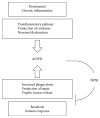The Role of Immunosenescence in Neurodegenerative Diseases
- PMID: 29706800
- PMCID: PMC5863336
- DOI: 10.1155/2018/6039171
The Role of Immunosenescence in Neurodegenerative Diseases
Abstract
Aging is characterized by the progressive decline of physiological function and tissue homeostasis leading to increased vulnerability, degeneration, and death. Aging-related changes of the innate and adaptive immune system include decline in the preservation and enhancement of many immune functions, such as changes in the number of circulating monocytic and dendritic cells, thymic involution, T cell polyfunctionality, or production of proinflammatory cytokines, and are defined as immunosenescence. Inflammatory functions are increased with age, causing the chronic low-grade inflammation, referred to as inflamm-aging, that contribute, together with immunosenescence, to neurodegenerative diseases. In this review, we discuss the link between the immune and nervous systems and how the immunosenescence and inflamm-aging can contribute to neurodegenerative diseases.
Figures



References
Publication types
MeSH terms
LinkOut - more resources
Full Text Sources
Other Literature Sources
Medical

